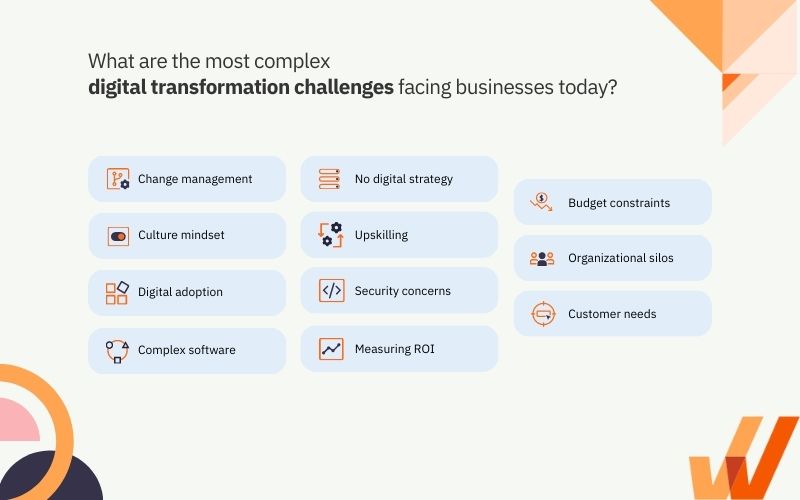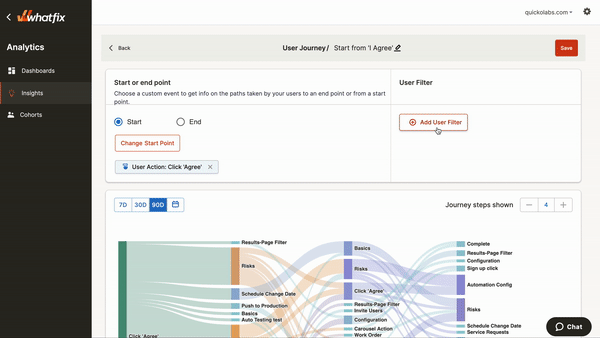
Levi Olmstead


In an era marked by rapid technological advancement, digital transformation has become a key strategic priority for businesses. As organizations strive to adapt and thrive in this digital age, they’ll likely encounter various challenges that must be navigated effectively.
Digital transformation is not simply about integrating new technologies into an organization’s operations— it requires a holistic shift in how a business operates, engages with customers, and delivers value. This comprehensive transformation affects all facets of an organization, from its business model to its culture, and requires significant change management.
Change management is a crucial component of a successful digital transformation. It involves preparing, supporting, and helping individuals and teams within an organization to adopt and adapt to changes. It is a complex task often met with resistance, misunderstanding, and fear. With digital transformation, the scale of change is often large and fast-paced, making change management even more challenging and even more important.
In the face of these complexities, a clear understanding of the potential challenges can help organizations pave a more efficient and successful path toward digital transformation. The journey may be difficult, but with strategic planning, effective change management, and a robust understanding of the challenges, businesses can position themselves for long-term success in the digital era.
Digital transformation is not only adopting new software, technologies, and processes that are more efficient and automated than traditional business practices and processes; it’s an entirely new, innovative way of doing something that is core to your business.
That means organizations must consider everything when taking on a digital transformation initiative – from how people will react to the change, how it will impact customer relations, the cost, how it will align with business goals, etc. Digital transformations empower organizations to take their business into the future, position companies to withstand competition, and grow into new areas.
Digital transformation is difficult for several reasons, including:
While digital transformation presents unique opportunities for organizations to innovate and grow, it also forces critical thinking and potentially reimagining aspects that are core to your business.
Regardless of the industry – from manufacturing to pharma digital transformation – you will encounter challenges. Here are the 11 most important challenges to consider when undertaking digital transformation projects in 2024:

Organizations with a thorough change management strategy are six times more likely to meet or exceed digital transformation objectives. Having a solid change management culture is crucial for any organization’s success— a lack of a change strategy sets any new project or implementation plan up for failure.
An effective change management strategy involves planning a project by identifying the root causes of issues– and building relationships with all stakeholders and employees.
You can begin to craft your change management strategy with our change management plan template below:
✓ Thank you, the checklist will be sent to your email
Enterprise software is inherently complex and new technologies can be intimidating. This is a large challenge for organizations undergoing digital transformation – both from an implementation and data integration perspective, as well as an end-user experience perspective. Leaders should consider this in the early stages of a transformation project and seek out the most intuitive, integrated systems.
New processes and technologies often present challenges in the form of resistance to change from tenured employees who feel there is nothing wrong with how they’re currently doing things. For new software implementations, organizations must provide comprehensive onboarding training and continuous employee performance support to help employees become productive and proficient with a tool quickly, allowing them to understand the value of these new processes.

Above: With Whatfix for digital transformation, you can create in-app performance support and self-help content for your enterprise applications such as Salesforce.
Organizations are constantly evolving, and COVID-19 undeniably accelerated this. Digital transformation is not an easy project, and intensive transformation efforts can take years to accomplish.
What happens if, during that time, your customer needs change? The evolution of customer problems will happen. Don’t be surprised; be proactive and plan to be agile when it comes time to adopt new digital technologies.
Why are you replacing legacy systems and manual processes with new digital systems? Does your organization have a plan (or need) to implement advanced and complex systems? Are you ready to properly migrate your existing systems into new ones?
These questions should be answered before implementing a digital transformation process. There is no such thing as a successful transformation project without a predetermined strategy. Don’t be sold on false assumptions and buzzwords. Choose from the variety of digital transformation models available, based on where your organization can improve, and what areas of the company need an upgrade.
To succeed in your transformation efforts, you’ll need a skilled, high-performing IT team. And that is difficult to put together – especially in the current tech worker shortage. According to an enterprise study, 54% of organizations said they’re not able to accomplish their digital transformation goals because of a lack of technically-skilled employees.
The challenges presented to organizations include a lack of skill sets in cybersecurity, application architecture, software integrations, data analytics, and data migration. Organizations that lack IT professionals can combat this challenge by outsourcing this work to outside consultants and digital transformation experts to help bridge the implementation and migration gap.
However, for organizations taking digital transformation seriously, creating an in-house team or having a digital transformation leader within your organization’s IT team that can create and manage your IT strategic planning is a must.
A pushback many enterprise organizations in data-sensitive industries have is privacy and cybersecurity concerns. Most digital transformation efforts involve leaving behind on-premise solutions to move to the cloud and integrating all of a company’s data into one centralized system.
Of course, this increases the threat of cyberattacks stealing customer data and company secrets. Online attacks can target system vulnerabilities, poor setups, and unsuspecting users. Be sure to have a plan in place to proactively mitigate these threats before they happen. Bring in a cybersecurity expert to help identify weaknesses in your defense and provide cybersecurity training to your employees.
Digital transformation is not a cheap investment. For organizations with a less-than-stellar transformation strategy, scope creep can slowly start to push back deadlines and add in new work – all adding to the cost of a project. Add in any consultation work, changes in customer needs, or IT errors, and the cost of digital transformation drastically increases.
Identify your long-term goals and what ROI you plan to achieve from your transformation process. Doing so will help you understand what spending is too much and what room you have to increase your budget.
Organizations with legacy systems and manual processes often have an old-school mentality. Things change slowly, automation is frowned upon, and new technologies feel daunting to adopt.
A huge challenge of digital transformation is a cultural one. Everyone – from leadership to new employees – must be on the same page. Everyone should be ready to make changes in their day-to-day and not be afraid of learning new things.
In many organizations, departments or teams may operate in isolation, leading to poor collaboration and communication, inefficient resource allocation, duplicate efforts, and fragmented approaches that undermine the success of digital transformation initiatives. Poor organizational structure and the lack of interaction between teams can hinder the flow of ideas and innovation, while disjointed data may negatively affect decision-making.
Identifying the return on investment (ROI) for digital transformation projects can be difficult, as the benefits may not be immediately apparent or quantifiable. This challenge can lead to skepticism and reluctance to invest in future digital initiatives, slowing down progress.
Unlike traditional investments, the success of digital transformation projects may not be immediately apparent or quantifiable. Moreover, the value derived from digital initiatives often extends beyond financial metrics and includes improvements in customer experience, employee productivity, and business agility. This difficulty in accurately determining ROI can lead to skepticism and reluctance to invest in future digital initiatives, thus slowing down the progress of digital transformation efforts.
Here are seven strategies enterprises can implement to overcome the challenges of digital transformation and reach their potential with the empowerment of new digital systems and technologies.
A new digital application or process will not automatically be more effective – you’ll need to provide proper onboarding, training, and support to your employees or end-users to empower them to use these systems better. Invest in a digital adoption platform (DAP) to ensure your digital transformation project’s success.
DAPs like Whatfix provide organizations with no-code tools to create in-app content to provide a contextual onboarding experience and ongoing performance support.

With a DAP, organizations can create in-app guidance, contextual learning, and on-demand self-help with a no-code editor, helping to guide employees and other end-users through digital tools, tasks, and workflows. With a DAP like Whatfix, you can create:


The best digital adoption platforms also offer features that allow end-users to provide feedback on the training and support content, right when they’re using it. They also provide detailed analytics on what features are being used, what flows are the most successful, areas of your new digital tools that need to be explained further, what the overall product adoption level looks like among your organization, and more.

Whatfix’s DAP takes an enterprise approach to driving the adoption of new digital transformation projects and is one of the highest-rated enterprise DAPs on G2.com with a 4.6/5 rating across 260+ real-user reviews. You can read all of those Whatfix reviews here.

Look at your current workforce and identify those who are influential, innovative, and trustworthy. Bring together a cross-functional team consisting of these high performers to create a change leadership team. This team will help create a vision for your digital transformation process that aligns with business goals and is created by those who are connected to the inner workings of your organization.
This allows organizations to take a proactive approach to digital transformation initiatives focusing on the people aspect of change that ultimately accelerate digital transformation.
Not every change is an extensive digital transformation project. Digital transformation is a wholesale realignment of core processes, tools, and experiences. Most organizations have never gone through an entire transformation process and lack internal change agents, which challenges and intimates organizations.
Hiring a digital transformation consulting company will provide you with the comfort of professionals who have done this before and know what they’re doing. They’ll provide you with a framework and foundation for finding success, with a track record to back this up.
What are the reasons for your organization’s digital transformation? This should be front-and-center of everything you’re working toward when implementing new processes. Understand your customers’ needs, pain points, and friction areas in your offerings, products, and services. Analyze your current processes to identify outdated systems that need infrastructure improvement.
At the end of the day, your transformation process should align directly with your core business goals. It should empower employees to be better at their job functions, overcome customer experience challenges with more intuitive systems that solve customer problems, and drive more revenue for our organization.
At the core of digital transformation projects is a sense of organizational vulnerability. Leaders realize that to adapt and compete in a global, digital world, innovation and change must happen. But technology is changing rapidly and continues to scale faster than most realize.
Being agile means not being afraid to pivot. It means taking advantage of opportunities when they arise. The sheer fact that you’re going through digital transformation already shows you’re agile – but lean into this. Don’t be afraid of new processes and tools or changing traditional practices to new ones.
Encouraging employee feedback and involvement can be a valuable way to overcome digital transformation challenges by promoting a collaborative and engaged workforce. Actively involving employees in the process and seeking their input allows organizations to tap into their insights, identify potential roadblocks, and devise more effective solutions.
When employees feel heard and included in the decision-making process, they are also more likely to embrace and adapt to new technologies and processes. This sense of ownership and commitment can accelerate the success of digital transformation initiatives, fostering a more resilient and adaptable organization in the face of technological change.
As digital transformation is an ongoing process, it’s crucial to establish a system for continuous monitoring, measurement, and evaluation of the initiatives. Establishing a system for continuous monitoring, measurement, and evaluation empowers organizations to identify areas that need improvement and make adjustments in real-time. This proactive approach ensures that digital initiatives remain aligned with business goals, resources are allocated effectively, and potential issues are addressed before they escalate.
To help you align your systems with business goals, you could consider implementing a quality management system (QMS). Veeva Systems offers a great tool and Veeva QMS implementation is straightforward.
Ultimately, continuous monitoring and adaptation lead to a more successful and sustainable digital transformation journey, helping organizations stay competitive in the rapidly evolving digital landscape.
Overcoming digital transformation challenges is crucial for organizations that want to remain competitive and innovative in today’s rapidly evolving digital landscape. Organizations must address a variety of challenges, including technological barriers, organizational obstacles, and operational complexities. By implementing the strategies and tips discussed in this article, businesses can successfully navigate the journey of digital transformation and unlock their full potential.
One way to ease the digital transformation process and tackle these challenges is by leveraging a solution like Whatfix. Whatfix is a digital adoption platform that simplifies the adoption of new technologies, streamlines user onboarding, and drives employee productivity.
With its contextual, personalized guidance and in-app performance support, Whatfix enables businesses to accelerate their digital transformation initiatives and overcome common challenges with ease. By choosing Whatfix as a partner in your digital transformation journey, you’ll be better equipped to tackle these challenges head-on and achieve success in the digital era.
Accelerate the implementation of your latest digital tools with Whatfix today.
With a digital adoption platform like Whatfix, enable your employees with in-app guidance and contextual self-help IT support to accelerate the adoption of new software implementations, employee onboarding, change initiates, and more. Whatfix’s no-code editor enables IT teams with a no-code editor to create product tours, interactive walkthroughs, task lists, smart tips, pop-ups, self-help wikis, and more. Analyze and measure user engagement and software usage to identify friction points, measure digital adoption, and improve employee digital experiences.

Thank you for subscribing!